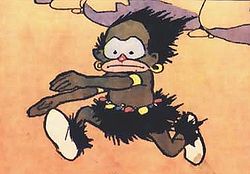
The Imp
Encyclopedia

Winsor McCay
Winsor McCay was an American cartoonist and animator.A prolific artist, McCay's pioneering early animated films far outshone the work of his contemporaries, and set a standard followed by Walt Disney and others in later decades...
's comic strip Little Nemo in Slumberland. The Imp is a little boy from a tribe of cannibals, and accompanies Nemo and their friend Flip
Flip (Little Nemo)
Flip is a character in the comic strip Little Nemo in Slumberland. He is the son of the Sun and nephew of the Dawn, something of a ne'er-do-well, and more or less an outcast: the residents of Slumberland want nothing to do with him. In his earliest appearances, he spends his time in Slumberland...
on various surreal adventures. The Imp, occasionally called "Impie", usually communicates in a nonsense language ("Ib ig de nuddle!"). In later strips, beginning in 1912, Impie sometimes speaks in an outlandish patois
Patois
Patois is any language that is considered nonstandard, although the term is not formally defined in linguistics. It can refer to pidgins, creoles, dialects, and other forms of native or local speech, but not commonly to jargon or slang, which are vocabulary-based forms of cant...
composed of snippets of several languages ("I bin sprecken bully good Amercano!").
Impie is a mischievous fellow, and delights in playing practical jokes, especially upon Flip, who often teases him.
The Imp is drawn as an extreme racial caricature, with features resembling minstrel show
Minstrel show
The minstrel show, or minstrelsy, was an American entertainment consisting of comic skits, variety acts, dancing, and music, performed by white people in blackface or, especially after the Civil War, black people in blackface....
makeup. The Imp's portrayal is one of the more problematic aspects of the strip for modern readers. Defenders point out that McCay was engaging in the sort of racial humor common in his time and that there is no intentional cruelty to McCay's humor. The other characters generally treat the Imp as an equal in their adventures, and, unlike much of the racial humor of the period, he is not singled out for special humiliation in the storylines: Nemo and Flip suffer as many comic misfortunes and pratfalls as does Impie.

Origin
McCay's first major comic strip series was Tales of the Jungle Imps by Felix Fiddle. Forty-three installments were published from January to November 1903, in the Cincinnati Enquirer. The strip was based on poems by George Randolph Chester, then a reporter and editor at the Enquirer. The stories concerned jungle creatures and the ways that they adapted to a hostile world, with individual titles such as How the Elephant Got His Trunk and How the Ostrich Got So Tall. In appearance, there is no difference between the imps in this strip and the character in Little Nemo.Other media
Unlike the four other major characters of the Little Nemo comic strip, the Imp did not make an appearance in the anime adaptation Little Nemo: Adventures in SlumberlandLittle Nemo: Adventures in Slumberland
Little Nemo: Adventures in Slumberland, known in Japan as simply Nemo, is a 1989 animated film directed by Masami Hata and William T. Hurtz. Loosely based on the comic strip Little Nemo in Slumberland by Winsor McCay, the film went through a lengthy development process with a number of screenwriters...
or the Nintendo adaptation of that game Little Nemo: The Dream Master
Little Nemo: The Dream Master
Little Nemo: The Dream Master is a platform game released on the NES in 1990 by Capcom. It is based on the Japanese animated film, Little Nemo: Adventures in Slumberland from Tokyo Movie Shinsha, which itself is based on the comic strip Little Nemo in Slumberland by Winsor McCay...
.

